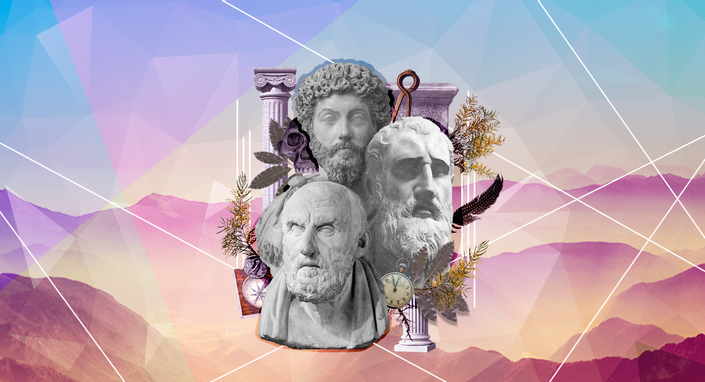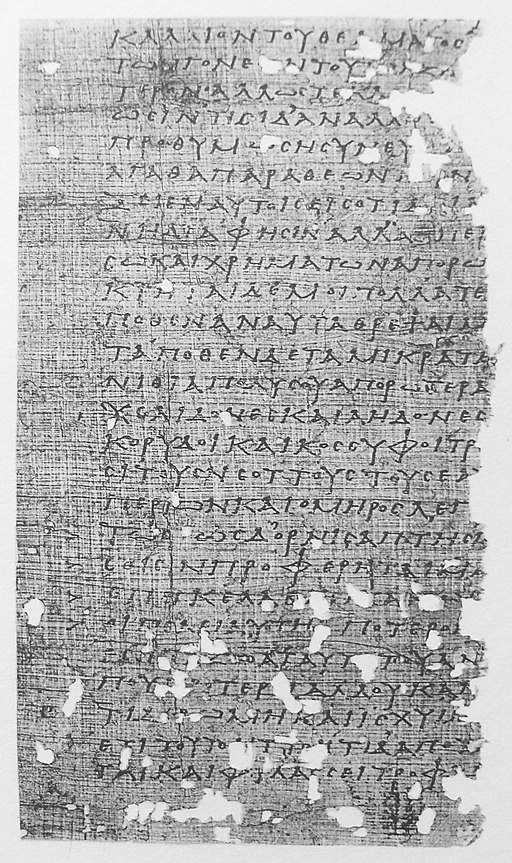Ideas don’t exist in the ether, so to speak. They are created by physically existing people who formulate them and then communicate them using words. If they are to be more than ephemeral, the words expressing ideas need to be written down or recorded in some physical medium. The ideas of the past are only available to us because they were recorded in this way and the physical objects containing them have either survived until today or at least long enough for another copy to be made. We only know about Stoicism because books, manuscripts, and papyri recording Stoic ideas have survived, in some cases for many centuries.
There were no guarantees that any Stoic texts would survive and, indeed, much has been lost. The Stoic authors that we read today are for the most part later figures, writing in the Roman imperial period. None of the works of the earlier Stoics active in Athens survive intact. The most prolific of the early Stoics, Chrysippus, is reported to have written 705 books, all of which are gone (a few fragments have been recovered recently from the charred papyri at Herculaneum). Chrysippus was writing at some time around 230 BC. In the early first century AD, around 250 years later, the Stoic Persius is said to have owned a complete set of Chrysippus’ works, passing them on to another Stoic, Cornutus, in his will. In the second century AD, writers such as Plutarch, Galen, and Aulus Gellius quoted from Chrysippus, so it seems reasonable to assume that copies of his works were still readily accessible then, by which point his texts were already some 400 years old. After that, though, things go quiet and the works of this great early Stoic disappear from view.
The earliest Stoic whose works do survive at length is Seneca. His works were composed in the first century AD and were widely read by Latin Church Fathers such as Tertullian, Augustine, and Jerome. Famously, Tertullian described him as “our Seneca”, which was taken by later Christian readers as an endorsement of this pagan author. The idea that Seneca was a friend of Christianity was cemented further by the existence of a series of letters between him and St Paul – now dismissed as a forgery but taken to be genuine in late antiquity and throughout the Middle Ages. This added to the popularity of Seneca, which no doubt contributed to the survival of his works.
All of Seneca’s shorter essays – On the Happy Life, On the Shortness of Life, On Anger, On Providence, and others – survive together in a single manuscript, dating from the eleventh century and now in the Biblioteca Ambrosiana in Milan. (Lots of later manuscripts of these works survive, but many of these are copies of this eleventh century collection.) It has been suggested that this manuscript was written at the famous monastery of Monte Cassino in Italy, copied from some earlier and now lost predecessor. These essays by Seneca were not widely known during the early Middle Ages so the surviving manuscript from Monte Cassino and the one from which it was copied may have been only thread by which these essays have come down to us today.
Alongside the essays, Seneca also wrote his famous letters to Lucilius. These circulated more widely during the Middle Ages and the earliest surviving copies are much older, dating to the ninth century. (You can see one of these, now in Paris, online at https://gallica.bnf.fr/ark:/12148/btv1b8426791q/f13.) There are other early manuscripts, also over a thousand years old, now in libraries in Florence, Venice, Leiden, and Oxford. Modern editions of Seneca’s correspondence with Lucilius contain 124 letters. We know that originally there were more than this (the writer Aulus Gellius cites a lost letter), so the collection we have is probably incomplete. An analysis of the surviving manuscripts shows that letters 1-88 and 89-124 were transmitted separately in two different volumes. It seems likely that there was originally a third volume that got lost along the way.
Our second famous Stoic author is Epictetus, although strictly speaking he wasn’t an author at all. The works we often credit to Epictetus were in fact written by a pupil of his, Arrian. We have four book of Arrian’s Discourses of Epictetus, along with Arrian’s shorter Handbook of Epictetus. Writing in the ninth century, the Byzantine writer Photius refers to eight books of Discourses as well as mentioning another work in twelve books. The second remark is usually put to one side, but his reference to eight books of Discourses is usually taken seriously, at least in part because we know that there were originally more than four books (Aulus Gellius is our source again; he quotes a passage from the fifth book).
The surviving four books exist in a number of manuscripts. All of these have a gap in the text in chapter 18 of book 1. In one manuscript, though, there’s an ink smudge over the text at this point, which led editors to conclude that all the other manuscripts must have been copied (directly or indirectly) from just this one copy.
(http://letsreadgreek.com/Epictetus/index.htm, Public domain, via Wikimedia Commons. Link: )
This manuscript dates from the eleventh century and is now in the Bodleian library in Oxford. It was presumably one of two volumes, with a second lost volume containing books 5-8. It came to Oxford in the early nineteenth century and before that it was in Verona. It presumably came to Italy from Byzantium, most likely in the fifteenth century. What we have of the Discourses looks to have survived thanks to this single copy, which itself might easily have been lost. The much shorter Handbook, by contrast, survives in dozens of manuscript copies, although none are older than the fourteenth century. It was also revised and adapted for use in monastic training, of which eleventh century copies survive.
The most widely read Stoic text today is probably the Meditations of Marcus Aurelius. We don’t know what happened to Marcus’ private notebooks immediately after his death. The earliest mention that we have is by Themistius, writing in the fourth century AD. Themistius had studied in Constantinople, where he was a senator and eventually prefect of the city. If Themistius did read the Meditations he presumably did so there, the new capital of the Roman Empire. The next firm sighting of the Meditations was also in the eastern Mediterranean, in the works of Arethas, Archbishop of Caesarea. Arethas reports that he owned his own copy of the Meditations. At some time around 900 AD, he had a new copy made and sent his old one to a friend, Demetrius. Elsewhere, Arethas refers to Marcus’s book using the title To Himself. This is the first mention of what has become the standard Greek title of the work. It has also been suggested that Arethas may have owned the Oxford manuscript of the Discourses of Epictetus (or its predecessor) and so may have played a key role in the survival of both the Meditations and the Discourses.
Today, our text of the Meditations comes from two main sources. The first is a complete manuscript, now in the Vatican Library. This manuscript is an anthology of Greek philosophical texts, containing not just the Meditations but also Xenophon’s Memorabilia of Socrates, one of the Christian adaptations of Arrian’s Handbook of Epictetus, and a collection of sayings by Epicurus. It dates to the fourteenth century. The second main source is the first printed edition of the Meditations, issued in 1559. This was based on a another manuscript, now lost, that had been in Heidelberg. (It was not uncommon for the manuscripts on which early printed copies were based to be effectively destroyed in the production process, as printers would rip out each page to consult closely when setting the type.) All we have now are copies of the first printed edition and the Vatican manuscript (plus some later manuscripts containing just excerpts).
Some other Stoic texts are more recent discoveries. A treatise on Stoic ethics by Hierocles was discovered on papyrus in the late nineteenth century and published for the first time in 1906. In 1936 another papyrus text was published for the first time and the following year was identified as part of a lecture by the Stoic Musonius Rufus.
(s. o., Public domain, via Wikimedia Commons. Link: )
The Discourses of Musonius Rufus survive mainly as extended quotations in an anthology compiled by a later author, Stobaeus. To bring us full circle, Stobaeus also included in his anthology the Hymn to Zeus by the early Stoic Cleanthes (pupil of the founder Zeno and teacher of Chrysippus). This is the longest text we have from an early Stoic at around two pages. It survives in just one copy, in a fourteenth century manuscript of Stobaeus, now in Naples (there’s a second manuscript of Stobaeus’ anthology, but the part that would have contained Cleanthes’ hymn is missing). Once again, this Stoic text was lucky to survive at all. So much has been lost and what does survive was often preserved in just one or two copies at most.
Yet, as we have seen, new discoveries are still possible. I mentioned earlier that some new fragments from Chrysippus have been recovered from the papyri at Herculaneum, a small town close to Pompeii that was buried in the famous eruption that consumed its more famous neighbour (find out more at YouTube ). Many of the Herculaneum papyri remain unopened and the former director of the research centre there, Marcello Gigante, once commented that he thought it would be highly likely that more Stoic texts would be found in the future.
John Sellars is Chair of Modern Stoicism, author of a number of books on Stoicism, and editor of The Routledge Handbook of the Stoic Tradition.






